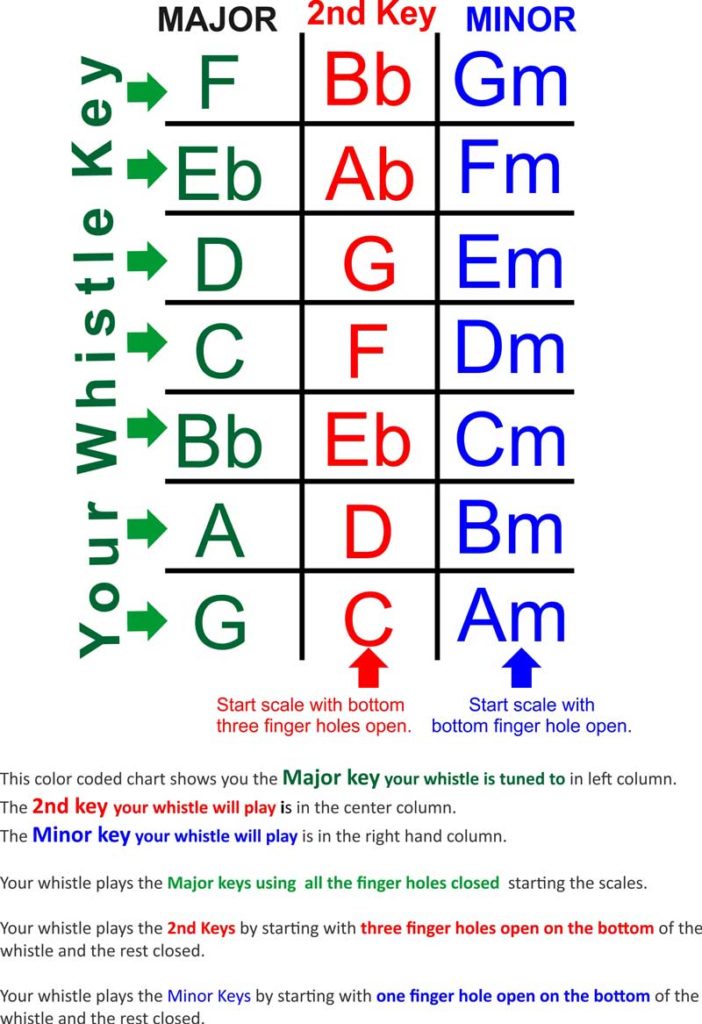The reason whistles play out of tune is cleanliness. Over a very short period of time, whistles begin to develop an interior coating from saliva and bits of food the same as your teeth get plaque buildup. Here is list of simple and quick things to solve this problem.
1. Swab your whistle frequently while playing and always swab before putting you whistle away for the day. Move the swab back and forth in the bore of the whistle. Next, insert the swab all the way to the mouthpiece plug. With the mouthpiece hole blocked, blow the whistle very hard at least twice. Saliva in the mouthpiece will blow into the swab and be absorbed without making any sound. Remove the swab and set it aside to dry out for the next time it is needed.
Occasionally you must rinse the swab in mild soap and water and stand it up to dry over night. Spraying the swab with Lysol disinfectant is a good idea. Clean the mouthpiece and all the finger holes with a Q tip.
2. Air conditioners and fans will disturb the air pressure in your playing area. Fans disrupt any echo you may have and add background noise that makes hearing your playing difficult.
3. Temperature is important for correct pitch in your whistle. Too cold an area will increase the moisture in the whistle bore which in turn dulls the whistles ability to make proper low notes. The whistle will play flat until it regains the heat it has lost.
Very hot temperatures will make whistles play sharp. Keep your whistle in the shade and out of the sun when playing in the summer.
Try to avoid playing the whistle and then laying it down for a period of time. When you pick the whistle up to resume playing it must warm up again and moisture starts to collect.
4. Lift your fingers over the holes high to avoid “shading” your sound. Finger holes are really little jets of air escaping the whistle and you want to keep them working properly.
5.Use hand cream to keep the tips of your fingers soft and pliable. The tips of your fingers will seal the finger holes easier and more completely and you will not have to grip the whistle as hard to play proper notes.
6. If your whistle has a joint to take the whistle apart…make sure it is tight and does not leak air.
If the joint is loose, the whistle will most certainly not play right or perhaps not at all!
Beeswax is excellent to seal the joint and will keep the joint from moving. If you need to break the beeswax seal, just warm it up and it will soften and let go. When replacing a beeswax seal, be sure not to get the wax in the bore of the whistle. Always buff the inside bore of the whistle after doing maintenance to your whistle.
7. When playing your whistle you must fill the bore of the whistle by tonguing the whistle on the starting note and when you take a breath of air to keep the whistle bore filled.
You cannot just blow the whistle, you must always tongue it to get a clear sound.
8. You get air from two sources when playing the whistle. The first is the breath in your throat and the second source is by taking a deep breath and filling your lungs. The small high D whistle generally can be played using only light breathing because it requires a minimum amount of air to play.
You will sound better if you take a deep beginning breath and then play.
Low whistles must be sharply tongued to fill the larger bore of the whistle. This requires a beginning deep breath or you will embarrass yourself by running out of air. The deep breath may need to be touched up a bit if the piece of music is long or louder than usual and you will have to practice to find where you inhale the extra air without it being noticed.

